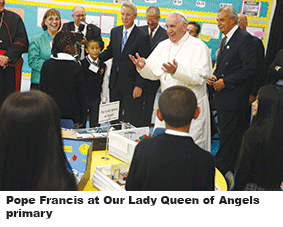United States: Catholic schools paradox
 According to Father Joseph Corpora of the University of Notre Dame’s Alliance for Catholic Education, the Pope’s visit on September 25 to the Our Lady Queen of Angels, a Catholic primary in Harlem, New York has drawn attention to the paradox of Catholic schools: they are highly successful, but starved of pupils.
According to Father Joseph Corpora of the University of Notre Dame’s Alliance for Catholic Education, the Pope’s visit on September 25 to the Our Lady Queen of Angels, a Catholic primary in Harlem, New York has drawn attention to the paradox of Catholic schools: they are highly successful, but starved of pupils.
Children at Catholic schools do better than neighbourhood public schools in standardised tests despite spending thousands of dollars less per student. Almost all their pupils graduate from high school and 86 percent go on to attend a four-year college. They are especially good at teaching minority children: Catholic-educated black and Latino pupils are more likely to graduate from high school and college. Yet despite their academic success, the number of Catholic primary schools has fallen by half since 1965, when Catholic schools had 6.5 million pupils. Today the total is less than 2 million, which means a lot of empty desks.
The main reason for the closures is financial. Catholic schools used to be financed by tuition fees, with help from the parish and archdiocese to fill gaps. But demography has undermined this model. In 1950, 76 percent of all Catholics lived in the north-east and the Midwest, which is where most Catholic schools are concentrated. Today, just under half do. In the south-west, Catholics are more plentiful, but they aren’t sending their children to Catholic schools as European immigrants once did, because those schools don’t yet exist.
Schools in the north-east and Midwest have been hit by both declining revenue and rising costs. Many parishes operate at a loss. Paedophilia scandals have added to the financial stress. Twelve dioceses and archdioceses have filed for bankruptcy since 2004. Legal fees and settlements have cost the American Catholic church billions.
For the past decade, desperate dioceses have been experimenting. Some schools, like Harlem’s Queen of Angels, are no longer part of a parish. Its church closed in 2007 and it’s now part of a network of six schools which retains ties with the New York archdiocese but does not receive any money from the church. Kathleen Porter-Magee, the partnership’s superintendent, calls it a 100-year startup. Its purpose hasn’t changed, though about 70 percent of pupils receive financial assistance and 89 percent qualify for free or cheap lunches. Nearly 70 percent of the pupils are Latino and 22 percent are black.
This increased distance between Catholic schools and individual parishes is part of a wider pattern. Some schools have merged, so that multiple parishes support one school. Others have formed groups, sharing administration and finances. Others have sponsors. On September 21, Stephen Schwarzman, boss of Blackstone, a private-equity firm, donated $40 million (Rs.261 crore) to pay for scholarships to New York’s Catholic schools. In Philadelphia, an independent foundation set up by the archbishop to run schools, has instituted scholarships, cut a $6 million deficit and centralised administrative functions. Innovation will not reverse the closures, says Sister John Mary Fleming, who heads Catholic education at the US Conference of Catholic Bishops; but it’s helping to stabilise Catholic schools.
One solution might be to attract more non-Catholics to these schools. Yet the simplest fix is also the least feasible. “If we could fly schools from Pittsburgh to Brownsville, we’d be in great shape,” says Father Corpora of Notre Dame. Brownsville, a Texan diocese on the border with Mexico, has just 14 Catholic schools and nearly a million Latinos.














Add comment